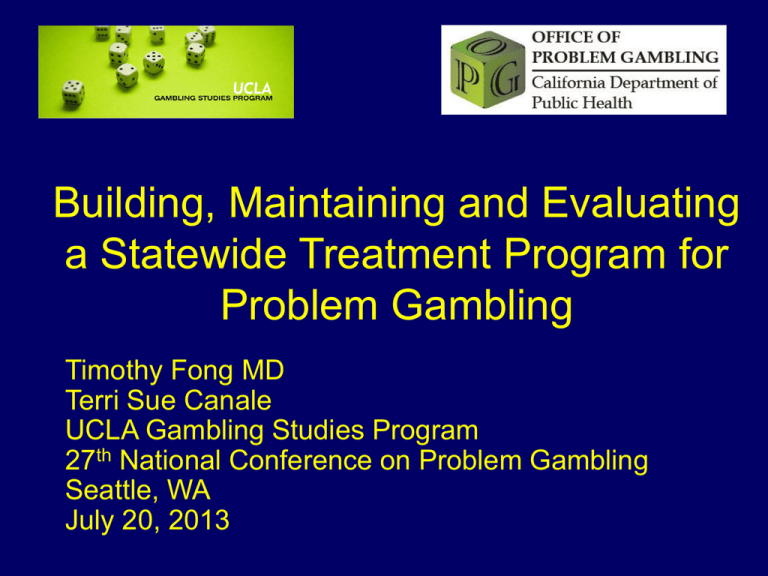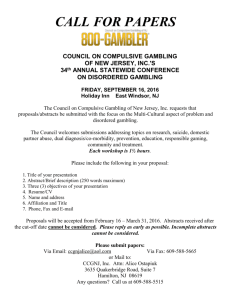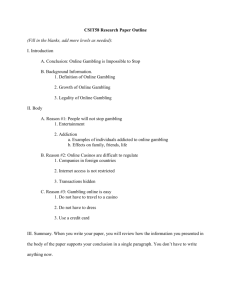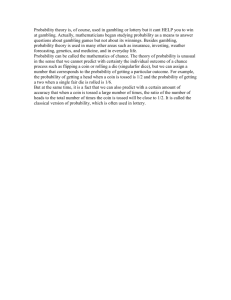Slide 1 - National Council on Problem Gambling
advertisement

Building, Maintaining and Evaluating a Statewide Treatment Program for Problem Gambling Timothy Fong MD Terri Sue Canale UCLA Gambling Studies Program 27th National Conference on Problem Gambling Seattle, WA July 20, 2013 Relevant Financial Relationships Dr. Fong Name Commercial Interests Relevant Relevant Financial Financial Relationships: Relationships: What Was For What Role Received Reckitt Benckiser Honorarium Speaker’s Bureau One80 Treatment Center Honorarium Speaker’s Bureau Psyadon Pharmaceutical Research Grant Research No Relevant Financial Relationships with Any Commercial Interests Building Budget • Approximately $8.7 M • No General Fund • Gambling Industry Tribal Gaming Cardrooms Lottery California Prevalence Study (2006) n=7,121 respondents, 18 years and older Problem gambling 2.2% Pathological gambling 1.5% ~1,000,000 problem/pathological cases Highest Risk: African-Americans, Disabled, Unemployed 1-800-GAMBLER California Problem Gambling Treatment Services Program (2009 – Present) Program Description • The CPGTSP was developed to meet the needs of the approximately one million gamblers experiencing problem or pathological gambling and also individuals affected by the gambler’s behavior. • Components: Provider Training, Treatment Services Network, Clinical Innovations at UCLA • Operations began on July 1, 2009 CPGTSP Development Timeline • 2009-2010 – Self-help workbooks available on website (07/09) – Phase I Training begins (10/09) – First California Problem Gambling Summit (03/10) – First residential client (06/10) – First telephone intervention client (06/10) – First IOP client (06/10) • 2010-2011 – Asian language telephone intervention begins(11/10) – DMS operations, Provider Education Resource Center created (02/11) – First outpatient client (02/11) – First supervision offered (04/11) – Clinical Innovations Affected Individual protocol begins (05/11) CPGTSP Development Timeline • 2011-2012 – Clinical Innovations counselor project begins (07/11) – Online Phase I Training developed (09/11) – Compliance monitoring reviews begin (12/11) – Helpline “warm transfers” 01/12 – First telephone intervention for affected individual (1/12) – First Phase II Training (04/12) • 2012-2013 – CPGTSP Treatment Utilization Report (06/12) – Northern California residential treatment site opens (10/12) – Group treatment (Expected) Provider Training Training Activities • 436 licensed providers and 20 additional attendees have completed the 30-hour CPGTSP Phase I Training. • Five Phase II trainings were provided to authorized providers as of June 2013. • As of June 30, 2013, there were 230 licensed, authorized CPGTSP outpatient providers and 404 supervision hours have been delivered. Treatment Services Network Problem Gambling Telephone Interventions (PGTI) • 1-800-GAMBLER (English/Spanish) • 1-888-968-7888 (Asian Languages) • Weekly sessions over the phone – Intake, 6 sessions, End of Treatment • Staffed by licensed trained therapists • Problem Gamblers and Affected Individuals • Goal is to engage and transition to live treatment CPGTSP Outpatient Provider Network • >250 authorized providers – (30 hrs of training, 10 hrs supervision) – MFT, LCSW, PhD • • • • Ongoing monitoring/support Therapeutic freedom Treatment blocks Access by: 1-800-GAMBLER or online directory / therapist locator CPGTSP Intensive Outpatient Program • • • • • • 3 days / week for 4 weeks (12 days) Comprehensive, integrated treatment Separate gambling-specific treatment Utilizes evidenced-based care Referrals from OP and RTC Operates in Los Angeles – Beit T’Shuvah Right Action Program CPGTSP Residential Treatment • Provide highest level of care for most severe cases • 30 days of treatment, >15 hrs / week • Integrated treatment with SUD • Located in Los Angeles and San Francisco – Beit T’Shuvah: 310-204-5200 – Health Right 360: 415-762-3705 CPGTSP: Clinical Innovations at UCLA • Efficacy of manualized treatment and determine best practices • Enhancing effectiveness of counselors in providing treatment • Mindfullness for problem gambling • Manualized therapy for romantic partners of PG 20 Maintaining CPGTSP Maintenance • • • • • • Supervision Compliance Monitoring Report Yearly Summit CEU requirement Phase I and II trainings Stakeholders Meeting Evaluation Early Treatment Indicators Report (2009-6/12) • • • • • Characteristics of CPGTSP Clients Treatment Utilization Treatment Impact Client Feedback about the CPGTSP Characteristics of CPGTSP Providers CPGTSP Data • Large database on gamblers and affected individuals – Some time required for the database to mature – Capabilities of the data management system are still being explored Problem Gambling Telephone Intervention BDA: English/Spanish Language Telephone Intervention • 542 gamblers served, mean age = 46 years old, 52.2% male; 38.9% currently married • 60.5% White; 17.9% API; 14.1% African-American • 28.9% Hispanic • 95.1% had NODS scores greater than 5; most owed money to family or friends (44.9%); 9% reported legal problems due to gambling • Top four gambling activities: slot machines (64.4%); black jack (27.5%); lottery (26.0%); poker (19.0%). • Tribal casinos most frequent referral source (41.4%) • Mean number of sessions = 3.5 Abstinence from Gambling 78.0% 76.0% 74.0% 72.0% 70.0% 68.0% 66.0% 64.0% 62.0% 60.0% 58.0% 76.3% 64.1% Session 1 Session 3 Outpatient Treatment Network Gamblers Served by Modality 159 (7%) 38 (2%) 110 (5%) 542 (24%) 24 (1%) 1,383 (61%) PGTI Outpatient Treatment Network Residential Treatment NICOS IOP Only Cinical Innovations Affected Individuals Served by Modality Highlights from the Early Treatment Indicators Report • Across all treatment components: – Reduction in PG symptoms, gambling behavior, and the harm caused by gambling – CPGTSP clients met 8 out of 10 DSM-IV criteria for pathological gambling – Preferred form of gambling across all clients was slot machines, followed by casino table games Highlights from the Early Treatment Indicators Report – AIs were mainly spouses or partners of gamblers – AIs spent less time in treatment than gamblers – More sessions received, better the outcomes – Client feedback regarding their experience in the CPGTSP was highly positive Change in NODS Scores for Outpatients Variable N At Intake 1293 8.16 1.85 At End of Treatment 1293 6.66 3.1 Difference Mean 1293 1.5 SD 3 Paired t Test Pr > Value |t| 18.02 <.00 01 Proportion of Outpatient Clients Who Gambled by Treatment Visit 90 80 Proportion 70 60 50 40 30 20 10 0 0 2 4 6 8 Visit 10 12 14 16 Affected Individuals BDA: English/Spanish Language Telephone Intervention • 25 served; mean age = 48 years old; 68% were female; 62.5% were currently married • 70% White, 17.4% API, 4.4% AfricanAmerican • 12.5% were Hispanic • The primary referral sources were the internet (33.3%) and tribal casinos (26.7%) • Mean number of Tx sessions = 3.5 NICOS: Asian Language Telephone Intervention • 11 served; mean age = 47 years old; All were female; 90.9% were currently married • All participants were API • Types of debt: credit cards (40.0%), other (26.3%), family/friends (20.0%), casino (0.0%) • Primary referral sources were the media (36.4%), helpline (36.4%), and community presentations (10.0%) • Mean number of Tx sessions = 7.7 Outpatient Treatment Network • 403 served; mean age = 46 years old; 72.0% female; 59.8% were currently married • 64.2% White, 12.7% Asian, 6.2% African-American • 28.9% were Hispanic • Most common type of debt was to family/friends (29.8%); 7.1% reported legal problems due to gambling • Primary referral sources were 1-800-GAMBLER (22.8%) and family/friends (21%) • Mean number of Tx sessions = 4.1 Data Strengths • • • • • Very large sample Capturing information at point of entry Tracking in-treatment information Overlapping data points across forms Universal forms allow some comparisons across treatment modality • Broadness of data collection can generate questions for in-depth study Strengthening CPGTSP 1. 2. 3. 4. Invest in quality assurance practices Empower workforce to take ownership Providing ongoing supervision is critical Clients using Internet for main source of information 5. Continually involve stakeholders 6. Add 30% time to administrative changes / policies Strengthening CPGTSP 7. Evaluate outreach techniques 8. Treatment supply and demand fluctuates rapidly 9. Prepare for unexpected events in advance by having flexibility in administration and operations 10.Reduce healthcare bureaucracy Now what? • • • • • • Research partners needed! Ongoing quality assurance Increase visibility of CPGTSP Seek permanent funding Balance supply and demand Forge more collaborations Contact Information Timothy Fong MD Terri Sue Canale 310-825-1479 (office) tfong@mednet.ucla.edu uclagamblingprogram.org






